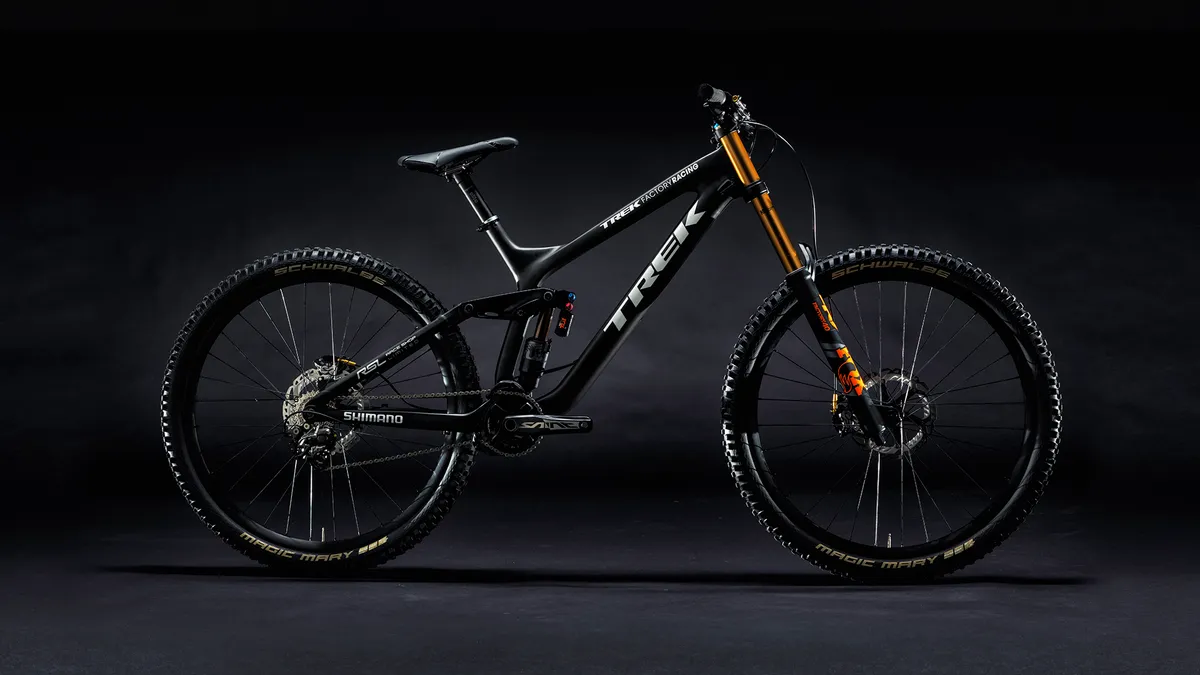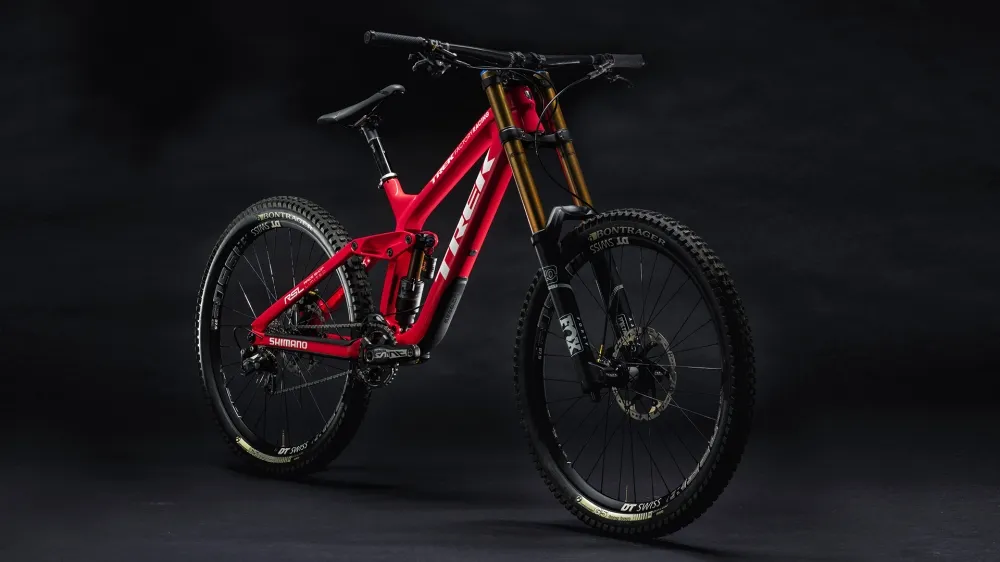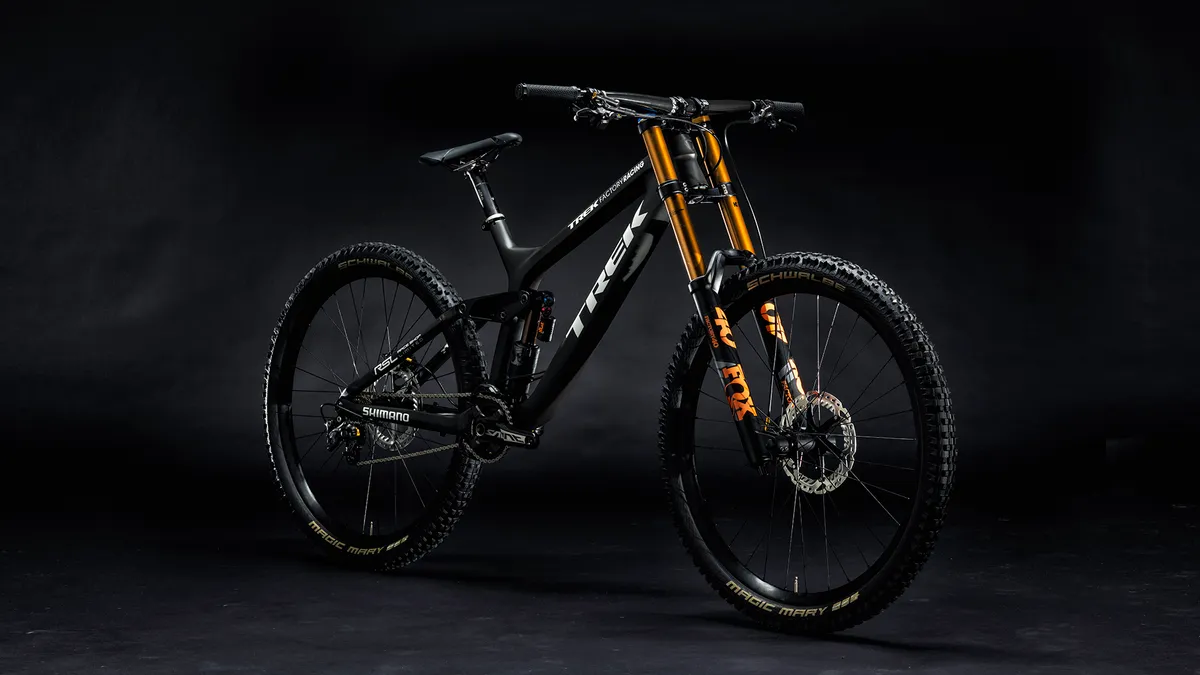Those with sharp eyes may have noticed that Trek World Racing competed aboard a new version of the Session downhill bike at the first round of the UCI Downhill World Cup in Lourdes, France. More obviously, Gee Atherton rode a 29in Trek Session at the British Downhill Series race in Fort William a couple of weeks ago.
Trek has just dropped all the juicy details on the brand new bikes. Here’s what’s new about the redesigned Session 29 and 27.5, which will be available to buy from August 2017.
29er frameset
Trek has been working on a 29er downhill bike since before it was cool. Since 2009, in fact. A later prototype was winning races in the US in 2015, but it was never raced at on the world cup circuit. That looks set to change this year, however.
The new Session 29 shares many of the features of the new Session 27.5, including the suspension layout and adjustable geometry. The geometry is a little different, though. The reach is slightly shorter per size, while the chainstays are just a touch longer, at 450mm. Weirdly, the 29er’s head angle is slacker than the 650b bike, at 62.1 degrees rather than 63 degrees, in the low setting with the standard headset. The fork has slightly more offset, which will quicken the steering slightly, but the all-important trail measurement is far longer on the 29er, suggesting calmer, more stable steering.

Trek claims that when it back-to-back tested the 29er and 650b versions of the new Session, the 29er was considerably faster. Apparently, Atherton went four seconds faster over a two-minute course. Using LITPro on-board telemetry, Trek reckons the big-wheeled bike wasn’t just faster overall, but that there was no point on the test track where the 29er was appreciably slower.
Even so, Trek anticipates 90 percent of its Session sales will be made up by the Session 27.5, with the 29er remaining the choice of serious racers only.
The new Session’s lower, longer, and slacker
Trek’s Mino Link system allows the bottom bracket height to be adjusted by 8mm, along with a head angle change of around half a degree. The old Session’s bottom bracket height was 356mm (2mm BB drop) in the low setting. That’s not exactly slammed low, and as a result few riders (racers in particular) ever used the high position. The new Trek Session comes up at 356mm in the highest setting, and 349mm in the lowest.
That’s moderately low for a downhill bike, but not the lowest. For context, a Specialized Demo (one of the lowest) measures up at 342mm (12mm drop), while a Canyon Sender is a little taller, at around 350mm (6mm drop).

In addition to the Mino Link, Trek will ship the bikes with offset headset cups to further tweak the head angle. As standard, that number now sits at 63.0 degrees in the low setting (down from 63.6 degrees on the outgoing bike), while offset cups can steepen it or lower it by one degree. Combined with the Mino Link, this gives a total head angle range of 62.1 to 64.4 degrees – enough range to race the steepest tracks one day, and play in the bike park the next.
As for the longer part, reach numbers have gone up by around 20mm in each size. A large now measures 445mm in the low setting, up from 425mm. The size XL has a reach of 470mm, which puts it at the longer end of the spectrum for downhill bikes, but it’s still shorter than the Canyon Sender – one of the longest – which measures 480mm. We think Trek could’ve gone longer still. Despite the increase in length up front, Trek decided to keep the chainstays the same length, at 446mm.
The Full Floater suspension is gone
As with the Slash enduro bike, Trek decided to do away with its Full Floater suspension design – in which the shock was attached to an extension of the swingarm, and so moved with the suspension – in favour of a fixed lower shock mount. Trek says this allows it to make the frame stiffer, lighter, and still allows it to get the kinematics as it wants them.
We pressed Trek as to why it bothered with the Full Floater design in the first place. It says it was needed to give the bike extra “plushness” off the top. But, it says, modern shocks have less need of this, and so the fixed shock mount works just as well. You can read more about that in the interview at the bottom of this article.

Trek says it has developed the suspension kinematics in conjunction with Fox, helping them work better with the Fox Float X2 air shock. The shock uses the metric standard, and the upper mount runs on cartridge bearings, rather than bushings, to keep friction down.
Apparently, the new shock has a more progressive damping curve than previous models. What does that mean? Well, progressive damping (as opposed to digressive) implies a relatively high degree of damping force at high speeds, with relatively little resistance at low shaft velocities. This means better sensitivity over small bumps, and a firmer response to big impacts such as hard landings.
The downside of progressive damping is relatively poor pedalling and chassis stability, with a relatively harsh feel over bigger bumps. Interestingly, it’s pretty much the opposite of Trek’s RE:activ damping curve used on some of its trail bikes, which favour pedalling efficiency and comfort over downhill traction and big-hit control.
Trek points out that the new Session will still work with a coil shock if you so wish – the leverage curve is progressive the whole way through the stroke.
It’s got stiffer
Trek claims that thanks to the new suspension layout and a (bike industry cliché alert) ‘optimized’ carbon layup, the weight of the frame remains unchanged while stiffness has been increased. According to Trek, stiffness around the head tube is up 10 percent, BB stiffness 19 percent, and for the frame as a whole, 11 percent.

Whether more stiffness is necessarily a good thing is up to you, but Trek says it did this to make the bike more responsive.
Pricing and availability
The Session 27.5 will be available as a frameset and a complete bike. The 29er will be sold as a frame and fork only.
- Session 9.9: $7,999.99 (£TBC / AU$TBC), Available September
- Session 27.5 Carbon frameset – frame + FOX X2 shock: $3,999.99 (£TBC / AU$TBC), Available August
- Session 29 Carbon frameset – frame + FOX X2 shock + FOX 40 29er fork: $4,999.99 (£TBC / AU$TBC), Available October
For more info, visit www.trekbikes.com
-------
Trek interview
We quizzed Trek's mountain bike brand manager Travis Ott, advanced concepts engineer Dylan Howes and suspension director Jose Gonzalez on the company's new Session bikes.
BikeRadar: If going to the fixed shock mount makes it stiffer, lighter, and allows you to get the suspension character how you like it, what was the need for Full Floater in the first place? How does the leverage curve compare between the old and new layouts?
Travis: Full Floater allowed us to get the suspension performance we wanted out of the bike and shock. Not just on Session, but all of our Trek full suspension bikes. However, with improved shock performance and tuning combined with the fact that we coordinated with Fox as we developed our bike and its new X2 air shock at the same time, we were able to get the desired suspension performance out of a fixed rear shock mount.

Dylan: The leverage rate follows the same overall progression percentage rate. However, it is a bit lower. It is very slightly more progressive at beginning travel for a slight increase in small bump sensitivity. The lower overall ratio (total rear wheel travel/total shock stroke) allows us to go with a lighter spring rate for a given rider weight compared to the previous bike. But more importantly for the air shocks, it also allows lower spring pressures.
Jose: The lower leverage ratio makes the damper more sensitive to motion – you’re moving more damper for the same amount of wheel motion. This complements the work done to the Float X2 and vice versa.

This chart compares the old 27.5 bike with the new 27.5 bike. The 29er follows the same rate as the 27.5 bike. Due to having 190mm travel with a 70mm shock, the overall rate is a fraction of a percentage different (0.3 percent lower for the 29er), so is essentially the same.
BR: Why is the 29er slacker than the 27.5?
Travis: With the range of adjustability in the frame and head tube you can get to the same or desired head angle. To elaborate, the 29er is slacker because we used the same mainframe for the 27.5 and the 29er. Because we kept the BB-to-ground height the same, the frame had to 'tip up' to accommodate the larger front wheel. But because we had already developed the angle change cups for the 27.5 bike, we simply used those to get the standard HT angle back to 63 degrees. For both bikes, we feel they ride best at 63 to 63.5 degrees (the range of HT angles with Mino in Low and High). But we know riders will want to adjust the bikes to their preference and potentially to specific track conditions. This is why we built in this adjustability for the rider. Overall, it’s slacker because of using the same mainframe on both bikes, but the intent is to ride it at the nominal 63 degree setting.
BR: Why did you decide to keep the rear-end the same even as the front end got longer?
Travis: The rear end is actually slightly longer on the 29er than the 27.5. In Mino Low, the 27.5 has a 446mm CS length, while the 29er has 452mm. Because the 29er fork has a longer offset compared to the 27.5 (58mm vs 52mm), we lengthened the back end just a bit to keep the rider weight centred in the same position. We’ve experimented a lot over the years with different CS lengths, and a slight increase in rear-centre length helps add stability in addition to keep weight centred. This change in length had no effect on manoeuvrability of the 29er in tight terrain.

